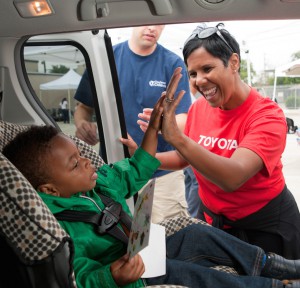
Toyota is working with dozens of hospitals across the country to help parents understand how to properly install child safety seats in cars.
After a decade of efforts to teach parents how to do it right, statistics show that three out of four parents in the United States are still installing child safety seats incorrectly.
Child Passenger Safety Week is a chance to remind drivers of the importance of using seat belts and to become reacquainted with the proper use of child safety and booster seats for children under the age of 12.
One program, Buckle Up for Life, launched in 2004 by Cincinnati Children’s Hospital Medical Center and Toyota, to save children’s lives, is working to change those statistics.
During that time, it has grown to include a network of more than a dozen of the nation’s leading children’s hospitals and worked with more than 17,000 people about the proper use of car seats and seat belts.
The statistics surrounding improperly buckled children are startling. According to the Centers for Disease Control:
- Car seat use reduces the risk for death to infants (children less than 1 year old) by 71%; and to toddlers (aged 1–4 years) by 54% in passenger vehicles.
- Booster seat use reduces the risk for serious injury by 45% for children aged 4–8 years when compared with seat belt use alone.
- For older children and adults, seat belt use reduces the risk for death and serious injury by approximately half.
The program expands this year to three new cities through partnerships with Boston Children’s Hospital, Lucile Packard Children’s Hospital in Stanford, California, and Maynard Children’s Hospital at Vidant Medical Center in Greenville, North Carolina.
Toyota has donated more than 40,000 child safety seats since the advent of the program, and this year created a public service announcement that uses humor to remind parents about the importance of proper seat belt and child safety seat usage.
(Toyota taking crash-avoidance tech mainstream. For more, Click Here.)
“When we launched Buckle Up for Life with Toyota ten years ago, we believed that convening families, leading children’s hospitals and trusted community organizations could have a powerful effect on improving children’s safety,” said Dr. Victor Garcia, founding director of trauma services, Cincinnati Children’s Hospital Medical Center.
(Click Here for details on the new AMG beast Mercedes unleashed.)
In the areas where the program has been implemented, documented changes include:
- The rate of children unrestrained in cars decreased from one in four to less than one in 10;
- The rate of children in car seats increased from almost one in three to one in two; and
- A 15% increase in use of seat belts for adults, from 71% to 86%.
A study of five states that increased the age requirement for car seat/booster seat usage to 7- and 8-years old found that the rate of children using car seats and booster seats increased nearly three times and the rate of children who sustained fatal or incapacitating injuries decreased by 17%.
(To see more about BMW’s new 2-Series convertible, Click Here.)
The improvements are critical when, according to the most recent statistics, more than 650 children ages 12 years and younger died as occupants in motor vehicle crashes, and more than 148,000 were injured.
One CDC study found that, in one year, more than 618,000 children ages 12 and younger rode in vehicles without the use of a child safety seat or booster seat or a seat belt at least some of the time. Of the children who died in a crash in 2011, 33% were not buckled up.
